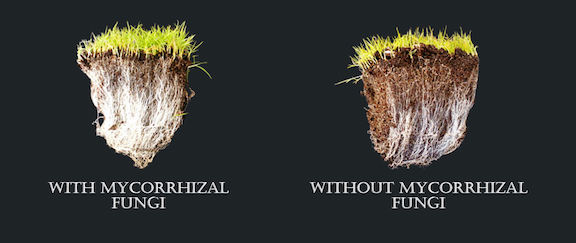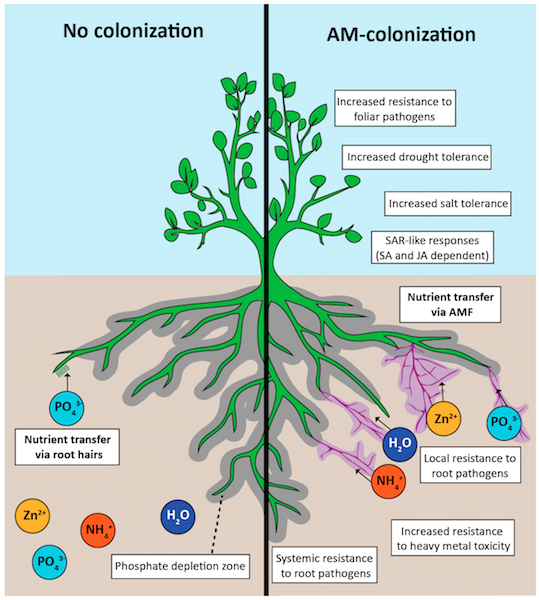Arbuscular Mycorrhizal Fungi
Introduction
Among the most profuse organisms on this planet, exist arbuscular mycorrhizal fungi (AMF). Most of these fungi lie within the Glomeromycota phylum, and form mutualistic symbiosis with the roots of as much as 80% of vascular plants. Arbuscular mycorrhizal fungi thrive in almost every region and area of the earth, influencing nutrient uptake for the plants that they surround, and protecting the plants from soil pathogens. Plant species richness is positively correlated with AMF richness, and higher AMF richness has been shown to increase general plant productivity. [10] Analysis of the molecular structure, along with studies and reports of fossilized fungal material, lead scientists to believe that the AMF derived with the first terrestrial plants. Because of this, it is thought that that the symbiotic relationship between the mycorrhizal fungi and plants may have been necessary for the adjustment of plants to the above ground environment from the Ordovician era. [5]

How do AMF and plant roots link?
Arbuscular mycorrhizal fungi subsist essentially as microscopic filaments called hyphae. The mycorrhizal fungal spore germinates asexually in the soil and makes their approach to the nearby roots; which get populated by the fungi, thus establishing mycorrhiza. When the fungi infiltrate the root, it creates an internal system of fungal structures within the root cells. Hyphae advance outside of the root, establishing a largely extensive network of fine fibers. This will pull in additional nutrients and water for the plant. These hyphae are articulated in a web like structure called mycelium. The mycelium is packed tightly around the roots and can extend outward toward other plants, to connect to their mycorrhizae as well. This new network can connect plants of different species from across the field/forest/jungle/garden etc.
The Symbiotic Relationship
Arbuscular Mycorrhizal fungi are shown to demonstrate and enhance community make-up, plant strength, diversity, and ecosystem performance. Nevertheless, plant systems have been recognized to affect the variety and composition of AMF as well. [7] AMF can transfer water to the plant, increase resistance to root pathogens and toxic metals, and get inadequately soluble nutrients (such as phosphorous, copper, and zinc) from the soil to the plant. In turn, the plant provides carbohydrates to the fungus. AMF are obligate biotrophs, depending on living root tissue for carbohydrate supply to complete their asexual life cycle. [4] Conditions that severely limit agricultural growth in some parts of the world, such as low water availability, are aided by this mutualistic symbiotic relationship, and is most likely necessary for optimal growth. [3]

AMF in Agricultural Practices:
AMF symbiosis accustoms plants for better survival and enhanced growth, thereby supporting sustainable growth and development of plants. [8] Since plants containing AMF are naturally stronger and healthier, competition within the diverse soil is inevitable. This helps plants with AMF be able to face environmental stress easier and more effectively. Fungal mutualists offer a biologically sound and sustainable alternative to chemical fertilizers and pesticides for managing both plant quality and quantity in agriculture. AMF are now seen as the cutting edge of sustainable agriculture. Thus, there is a necessity to speed up their integration in agricultural production systems. [8] "This is leading to the development of novel approaches in crop breeding and agricultural practices, encouraging the formation of mycorrhizal associations and utilisation of previously plant-inaccessible phosphorus pools." (Field; 2017) [9]
References
[1] Coleman, D. C., Crossley, D. A., Jr., & Hendrix, P. F. (2004). Fundamentals of Soil Ecology (2nd ed.). Amstherdan: Elsevier.
[2] Jacott, C., Murray, J., & Ridout, C. (2017). Trade-Offs in Arbuscular Mycorrhizal Symbiosis: Disease Resistance, Growth Responses and Perspectives for Crop Breeding. Agronomy,7(4), 75. doi:10.3390/agronomy7040075
[3] Kosuta, S. (2003). A Diffusible Factor from Arbuscular Mycorrhizal Fungi Induces Symbiosis-Specific MtENOD11 Expression in Roots of Medicago truncatula. Plant Physiology,131(3), 952-962. doi:10.1104/pp.011882
[4] Paszkowski, U. (2006). A journey through signaling in arbuscular mycorrhizal symbioses 2006. New Phytologist,172(1), 35-46. doi:10.1111/j.1469-8137.2006.01840.x
[5] Rosendahl, S. (2008). Communities, populations and individuals of arbuscular mycorrhizal fungi. New Phytologist,178(2), 253-266. doi:10.1111/j.1469-8137.2008.02378.x
[6] Treseder, K. K., & Cross, A. (2006). Global Distributions of Arbuscular Mycorrhizal Fungi. Ecosystems,9(2), 305-316. doi:10.1007/s10021-005-0110-x
[7] Velázquez, M. S., Cabello, M. N., & Barrera, M. (2013). Composition and structure of arbuscular-mycorrhizal communities in El Palmar National Park, Argentina. Mycologia,105(3), 509-520. doi:10.3852/11-353
[8] Lone, R., Shuab, R., Khan, S., K, J., & Koul, K. (2017). Arbuscular Mycorrhizal Fungi for Sustainable Agriculture. Springer Link, 553-577.
[9] Biological Sciences, University of Leeds, & Field, K., Dr. (2016). Plant-fungal symbioses and their applications in sustainable agriculture. Retrieved from https://www.fbs.leeds.ac.uk/staff/profile.php?tag=Field_K
[10] Klironomos, J. N., J. McCune, M. Hart, and J. Neville. (2000). The influence of arbuscular mycorrhizae on the relationship between plant diversity and productivity. Ecology Letters 3:137–141.